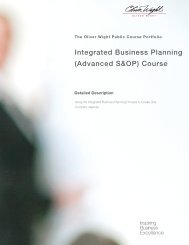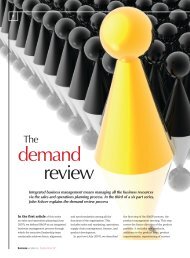Integrated Reconciliation Review - Oliver Wight Americas
Integrated Reconciliation Review - Oliver Wight Americas
Integrated Reconciliation Review - Oliver Wight Americas
Create successful ePaper yourself
Turn your PDF publications into a flip-book with our unique Google optimized e-Paper software.
Thelanguage<br />
ofmanagement<br />
<strong>Integrated</strong> business management means managing all of the business resources<br />
via the sales and operations planning process. Part five of John Schorr’s<br />
series of six articles reaches the integrated reconciliation review<br />
Sales and operations planning<br />
(S&OP) is an integrated business<br />
management process through which<br />
the executive/leadership team<br />
continually achieves focus, alignment,<br />
and synchronization among all of the<br />
functions of the organization. The<br />
monthly S&OP plan brings together all<br />
the plans for the business (customers,<br />
sales, marketing development,<br />
manufacturing, servicing, and<br />
financial) into an integrated set of<br />
plans. These plans are then reviewed<br />
by senior management at an aggregate<br />
(product family) level and the output<br />
of the process is a definitive statement<br />
of what the company plans to do for<br />
the next 24 months.<br />
Until now all the plans have been<br />
stated in units or rates of output. At<br />
what rate are we going to sell? At what<br />
rate are we going to manufacture?<br />
What are the resulting inventory<br />
levels or backlogs?<br />
However, to be truly effective,<br />
these plans must be converted to the<br />
language of senior management—<br />
revenue, profit, costs, cash flow,<br />
and so forth. The integrated<br />
reconciliation review step converts<br />
the plans from units to dollars, from<br />
rates of output to profit and loss<br />
impact, from functional plans to the<br />
10 Businessexcellence November 07
Strategicmanagement<br />
enablement of effective<br />
business management<br />
decision making at the<br />
management business<br />
review meeting.<br />
In this series we<br />
have described the<br />
first three steps of the<br />
sales and operations<br />
planning<br />
process<br />
(Figure 1): the product<br />
management<br />
review;<br />
the demand review;<br />
and the supply review.<br />
Each of the individual<br />
reviews was done<br />
within the functional<br />
area<br />
accountable,<br />
such as product<br />
development,<br />
sales<br />
and marketing, and<br />
manufacturing<br />
supply chain.<br />
and<br />
In the integrated<br />
reconciliation review each of these<br />
functional perspectives is evaluated<br />
and considered before combining<br />
them into an integrated approach<br />
that will guide the business<br />
operation. During this review the<br />
issues from the first three steps of<br />
“Experience has shown that where the<br />
sales and operations planning process<br />
is viable and effective, companies have<br />
named an S&OP coordinator to manage<br />
the process and the data”<br />
the S&OP process are identified, a<br />
financial appraisal of the functional<br />
plans is developed, the gaps to the<br />
strategic plans, business plans, and<br />
performance goals are documented,<br />
various scenarios are created around<br />
those issues/gaps, and assembled<br />
into the S&OP packet.<br />
There are essentially two<br />
key parts to this step: the<br />
financial appraisal and the<br />
integrated reconciliation.<br />
Financial appraisal begins<br />
with a financial evaluation<br />
of the plans from steps one<br />
through three (product,<br />
demand, supply) and a<br />
projection of the cash flow<br />
based on those plans. The<br />
financial<br />
assumptions<br />
are documented (future<br />
product mix, currency<br />
rates, customer mix,<br />
average selling prices, etc.),<br />
from which a “rough cut”<br />
financial plan is developed<br />
for the business.<br />
That rough cut financial<br />
plan is then compared to<br />
actual financial results to<br />
test the reasonableness of<br />
the projected financial plan. Once<br />
the financial plan is considered<br />
“reasonable”, the financials are then<br />
forecast for the next 24 months.<br />
Ultimately, the goal for this financial<br />
appraisal is to forecast, on a monthly<br />
basis, a full profit and loss statement<br />
November 07 Businessexcellence 11
for the upcoming 24 months.<br />
This financial appraisal will<br />
require an integrated view from<br />
demand, supply and finance. For<br />
example, the average selling price<br />
needs to be forecast for each family<br />
and sub-family over the planning<br />
horizon. This price forecast is<br />
provided as an output of the demand<br />
review, and must take into account<br />
product mix changes, pricing<br />
changes, promotions, etc. Variable<br />
costs, such as material, labor,<br />
and other variables, are forecast<br />
by purchasing, human resources,<br />
and production. This set of cost<br />
projections is provided as part of the<br />
output of the supply review.<br />
Purchasing forecasts the purchase<br />
price changes, by commodity, over the<br />
planning horizon. The cost of resources<br />
and other product management costs<br />
(tooling, etc.) are developed from<br />
the product management review.<br />
Overheads, period costs, and capital<br />
expenditures are forecast as well<br />
as cash flow plans generated from<br />
the operational plans. The financial<br />
data in this step converts the plans<br />
developed in steps one through three<br />
from units to dollars and allows senior<br />
management to better understand<br />
the impact of the plan on the profit<br />
and loss statement of the business.<br />
Once the financial evaluation is<br />
complete, the issues arising from<br />
“To be truly effective,<br />
plans must be converted<br />
to the language of senior<br />
management—revenue,<br />
profit, costs, cash flow,<br />
and so forth”<br />
steps one through three and the<br />
alternative plans developed to<br />
resolve those issues are reviewed.<br />
The plans are evaluated against the<br />
business plan, the strategic plan,<br />
and the performance metrics of the<br />
business. A gap analysis is then<br />
performed where there are shortfalls<br />
to the business and strategic plans<br />
or a performance metric such as<br />
EBITA (earnings before interest, tax<br />
and amortization).<br />
The individuals accountable<br />
for this step discuss the issues<br />
and gaps and create alternative<br />
solutions to resolve these<br />
issues and gaps. The<br />
integration reconciliation<br />
team then develops<br />
recommendations<br />
on<br />
the selection of the<br />
right alternative (or<br />
alternatives if there are<br />
valid scenarios around<br />
the issue or gaps) and<br />
fully costs and evaluates<br />
those alternatives. Once<br />
all the appropriate<br />
information is gathered,<br />
the group prepares the<br />
“S&OP packet” that is<br />
sent, at least 24 hours in<br />
advance, to the attendees<br />
of the management<br />
business review (MBR)<br />
meeting.<br />
There are some<br />
companywide<br />
projects<br />
or initiatives that do<br />
not naturally fit into the<br />
first three S&OP steps<br />
(product, demand, and<br />
supply). These projects are<br />
coordinated through the<br />
integrated reconciliation<br />
step. The integrated<br />
reconciliation team will<br />
communicate the impact<br />
of these projects or<br />
initiatives on common<br />
resources to the other process steps<br />
and recommend priorities for those<br />
projects. The senior management<br />
team will establish the overall<br />
priorities for these projects.<br />
12 Businessexcellence November 07
Strategicmanagement<br />
I was recently in a company that<br />
had 42 number one projects, many<br />
of which required the same resources<br />
to develop, manage, and implement.<br />
At best, companies can accomplish<br />
four or five major initiatives in a year.<br />
That’s why management must set the<br />
priorities and provide the resources<br />
for only a few critical initiatives<br />
in order for them to be delivered<br />
complete and on time.<br />
The initiatives, projects,<br />
resource requirements,<br />
schedules, and priorities all<br />
are included in the S&OP<br />
packet for management’s<br />
review, action and approval.<br />
The<br />
integrated<br />
reconciliation review meeting<br />
follows the supply review<br />
meeting by a couple of days.<br />
The inputs for the integrated<br />
reconciliation review meeting<br />
include the issues raised from<br />
the product management,<br />
demand, and supply meetings,<br />
the financial evaluation of the<br />
new plans and changes to<br />
the plan from the previous<br />
month, and the alternative<br />
proposals developed in the<br />
product, demand, and supply<br />
steps (figure 2).<br />
The<br />
integrated<br />
reconciliation meeting of the sales<br />
and operations planning process<br />
develops the financial evaluation<br />
of the plans, identifies the gaps to<br />
the strategic and business plans,<br />
develops scenarios around those<br />
gaps, and publishes the S&OP packet<br />
that will be used in the management<br />
review meeting.<br />
The S&OP packet is a critical<br />
component and requires some<br />
explanation. The packet contains the<br />
essential management information<br />
required for decision making. It is not<br />
a spreadsheet data dump but rather<br />
a packet of visual information that<br />
clearly spells out the issues and frames<br />
the decisions required (figure 3).<br />
The packet typically contains a KPI<br />
dashboard that provides management<br />
with a quick visual indication of<br />
business performance. Also in the<br />
packet is the documentation of a<br />
family-by-family summary of the<br />
trends, changes, assumptions,<br />
financial impacts of the changes,<br />
and appropriate recommendations.<br />
Gaps to the business and strategic<br />
plans are visually displayed with the<br />
supporting information documented<br />
as well as the recommended actions<br />
noted. The packet outputs in figure 3<br />
are from the <strong>Oliver</strong> <strong>Wight</strong> ESOPT<br />
presentation tool, and will be<br />
discussed in greater detail in the<br />
next article of the S&OP series.<br />
Experience has shown that where<br />
the sales and operations planning<br />
process is viable and effective,<br />
companies have named an S&OP<br />
coordinator to manage the process<br />
and the data. In effect, this person<br />
acts as the quality assurance<br />
manager for the S&OP process.<br />
The S&OP coordinator orchestrates<br />
the integrated reconciliation meeting,<br />
oversees the issue resolution<br />
process, and liaises closely with the<br />
coordinators and owners of each step<br />
of the S&OP process. The coordinator<br />
selects the integrated reconciliation<br />
issues, facilitates the appropriate<br />
players to develop scenarios that reoptimize<br />
the business and develops<br />
gap closing solutions. He/she<br />
orchestrates the discussions, both<br />
one-on-one and in small groups, and<br />
coordinates the development of the<br />
agenda for the senior management<br />
meeting to ensure an integrated and<br />
seamless process. This individual<br />
requires a broad-based experience<br />
(exposure to multiple aspects of the<br />
business) and must view issues from<br />
a “business” perspective.<br />
The sixth and final article in the S&OP<br />
series will address the management<br />
business review meeting.<br />
John E. Schorr, a principal with <strong>Oliver</strong> <strong>Wight</strong>, is one of the leading experts in sales & operations planning<br />
(S&P). Prior to joining <strong>Oliver</strong> <strong>Wight</strong>, John was involved in the implementation of MRP II at Haworth, where<br />
he was vice president of manufacturing, and Steelcase, where he was director of purchasing.<br />
November 07 Businessexcellence 13
















